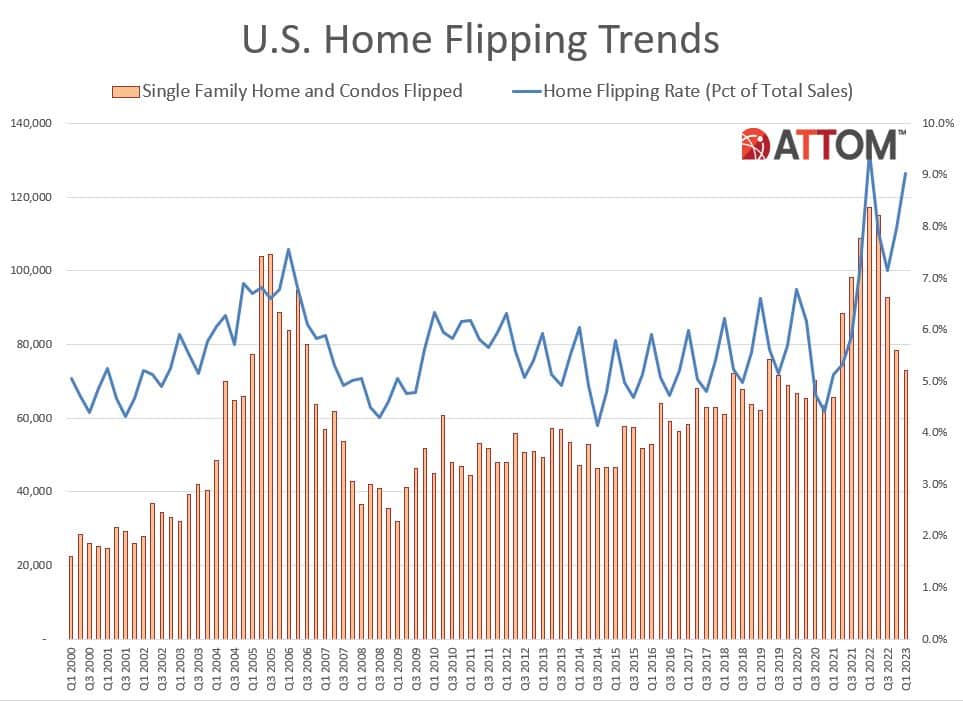However, investors shouldn't assume they're out of the woods just yet: CEO

One in 10 of all home sold across the US in the first quarter of 2023 were flipped single-family units and condominiums, new data shows. But while home-flipping continues to be big business, leading property data curator ATTOM advises flipping investors to continue to monitor data before declaring themselves out of the woods.
ATTOM has just released its US home flipping report covering the first quarter of 2023, showing that 72,960 single-family homes and condominiums in the US were flipped from January to March 2023, representing 9% of all home sales in that period. While this number represented a full-percentage-point increase from the previous quarter’s 8%, ATTOM noted that it was a 0.4% drop from the first quarter of 2022.
Profits and returns on investment from flipping houses similarly increased compared to the fourth quarter of 2022 but remained at some of the lowest levels seen over the past 10 years, reflecting an ongoing financial struggle for home flipping investors. ATTOM considered the quarterly gain in the typical profit margin of 22% as a “modest” bounce-back for investors following years of steady decline that began even before the US housing market began to struggle due to the pandemic.
“Home-flipping investors across the US may have finally halted the decline,” said ATTOM CEO Rob Barber. “In the first quarter, profit margins showed a slight upward turn after an extended slump, while interest in flipped homes continued to rise among buyers. However, investors shouldn’t assume they’re out of the woods just yet. Home-flipping carrying costs can easily erase a 22% return on gross profits, and it’s possible that the recent gain is merely a temporary blip. Nevertheless, the first-quarter trends offer some hope for investors indicating that brighter times may lie ahead.”
The gross profit of a typical US home flip – defined by ATTOM as the difference between the median price at which a house flipping investor buys a unit and the median resale price post flip – increased to $56,000 in the first quarter of 2023 from the $53,500 recorded in the immediately preceding quarter, but remained 20% lower than the average gross profit recorded this time last year, $70,000, and one of the lowest levels of gross profit since 2012, when the national housing market was recovering from the recession.
The typical profit margin from flipping likewise shot up with eight of the nine last preceding quarters recording declines. The $56,000 typically made from flipping throughout the first quarter of 2023 translated to a 22.5% return on investment. ATTOM said this not only represented a yearly drop from the 26.9% recorded in the first quarter of 2022 but constituted less than half of the levels recorded in the middle of 2020, when the profit margin was 51.5% on average.
Still, a 22.5% return on investment was an “[inch] up” from 21.7% – the return recorded in the fourth quarter of 2022. And profit margins for flipped homes generally went up throughout the US, or in 103 of the 172 metro areas analyzed (60%).

ATTOM’s national home flipping report also noted that the median resale price of flipped homes grew faster than they did back when home-flip investors were buying homes. It pointed out that in the first quarter of 2023, the typical resale price on flipped homes was $305,000 – 1.7% bigger than the $300,000 recorded in the fourth quarter of 2022, and bigger than home flippers were used to seeing, as at the time they had purchased their properties flipped-home prices were increasing by only 1% per quarter.
This recent, modest profit turnaround ran counter to the broader national housing market, where the return on investments was still consistently on decline. Rising mortgage rates, sustained record-high levels of inflation, and general economic uncertainty translated to home values dropping since the second quarter of 2022. ATTOM noted that the national median home price was now down by 7%. Home-flipping profits, on the other hand, started to change course earlier this year.
Even the volume of flipped-home sales in relation to home sales in general recorded a quarterly increase of roughly two percentage points or less in 128 of the 172 metropolitan statistical areas across the country that ATTOM had enough data on to study. Among those metros, the largest flipping rates during the first quarter of 2023 were in Macon and Atlanta, Georgia, where flips respectively comprised 17% and 15.3% of all home sales in the state. Macon and Atlanta were followed by Jacksonville, Florida, at 15.2%, Memphis, Tennessee, at 14.4%, and Clarksville, Tennessee, at 14.3%.
The areas where home flipping comprised the smallest share of all home sales were Indianapolis, Indiana, at 4%, Wichita, Kansas, and Bridgeport, Connecticut, at 5% each, Madison, Wisconsin, at 5.2% and South Bend, Indiana, at 5.3%.
Some of the biggest quarterly increases in the typical profit margin during the early months of 2023 came in Shreveport, LA (ROI up from 38.6% in the fourth quarter of 2022 to 92% in the first quarter of 2023); Lafayette, LA (up from 25.5% to 72.8%); Savannah, GA (up from 14.3% to 56.8%); South Bend, IN (up from 8.5% to 49.4%) and Peoria, IL (up from 40.7% to 75.7%).
Markets with the largest returns on investment for home flips during the first quarter of 2023 were:
- Scranton, Pennsylvania at a whopping 121.9% return,
- Pittsburgh, Pennsylvania at 109.8%,
- Flint, Minnesota at 94.9%,
- Shreveport, Louisiana at 92%, and
- New Orleans, Louisiana at 84.6%.
Finally, ATTOM noted that the average time it took from purchase to resale on home flippings increased on a quarterly basis from 165 to 178 days.



